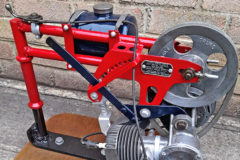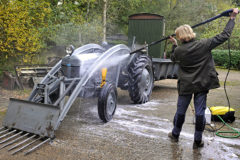The smallest Red Giant!
Posted by Chris Graham on 16th November 2021
The now rare Massey Ferguson 130 was the smallest Red Giant, but Norman Mitchinson owns a fine example, as Bob Weir discovers.
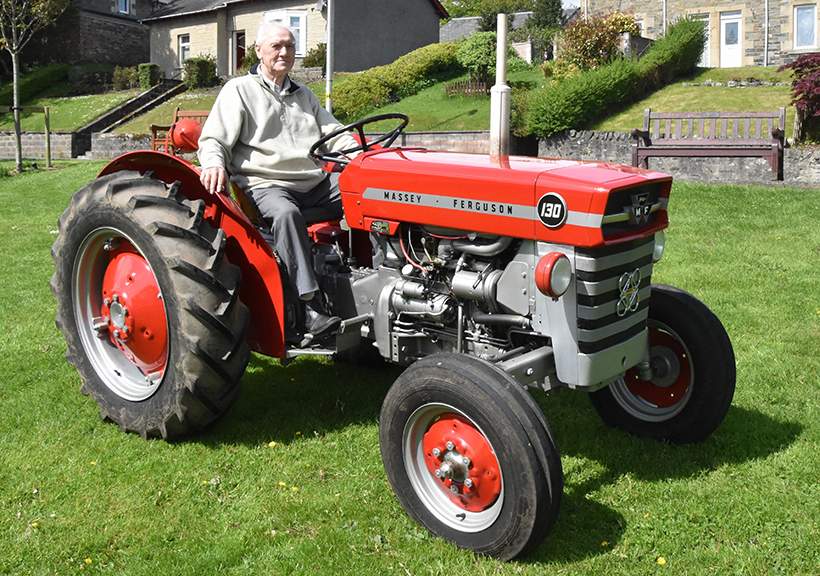
The smallest Red Giant: Norman Mitchinson with his ‘Economy’ Massey Ferguson 130.
Norman Mitchinson lives in Selkirk, which was formerly the county town of Selkirkshire. The Royal Burgh is one of the oldest towns in the Scottish Borders, and was prominent in the Scottish wool industry. These days the town is best known for its Selkirk Common Riding, which is held in the month of June. The ceremony features hundreds of riders, and is one of the largest cavalcades of horses in Europe.
Norman comes from a farming background and has lived in the Borders area all his life. “My father worked freelance and was involved in farm, dyke and drainage work,” he told me. “Back in those days you had to turn your hand to most jobs, as and when they became available. Although he started off working with horses, he was a tractor man for many years and would have driven various makes, including grey Fergies, Case and Fordson.”
Norman also went into farming after he left school, and worked in the local farm diary. “I worked in the diary for three years, but the hours were long, even by the standards of the day,” he recalls. “I was only allowed one weekend off a month, and had to get up at 4am every morning to milk the cows. It all got too much in the end, so I packed it in and became a lorry driver instead. I worked for the Co-operative Galashiels creamery, until it made the workforce redundant in the mid-1990s.”
Norman is now in his late 70s and can remember the days when farms were still transporting their milk using traditional churns. “You did the rounds of all the local farms collecting milk, and the job would take most of the morning,” he recalls. “The roads could get quite treacherous during the winter months, and you had to keep your wits about you. A lot of dairy farmers packed it when they switched to bulk tankers, because they couldn’t afford the investment. Times certainly changed, but I suppose it’s for the best.”
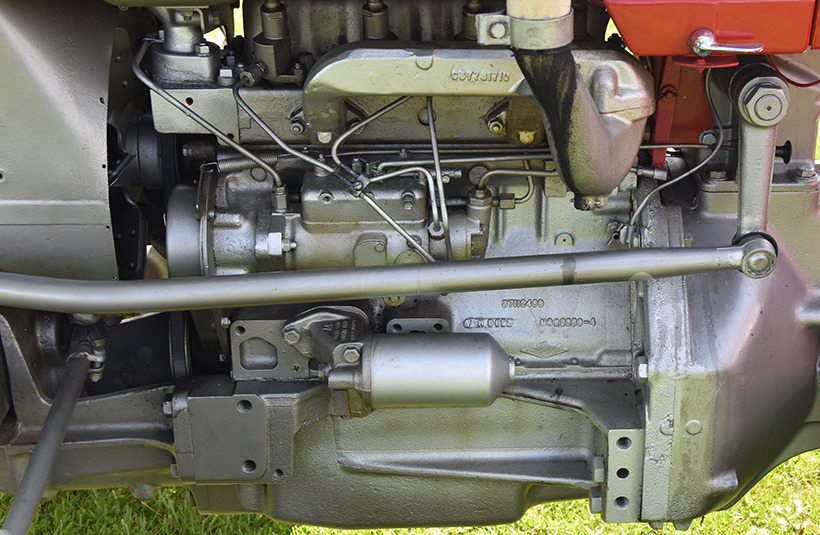
The 30hp, four-cylinder A4.107 engine was built by Perkins, to Massey Ferguson’s specifications.
Apart from collecting tractors, Norman has another interesting hobby; he’s been a radio ham for many years. “I got interested in amateur radio and decided to have a go,” he explained. “I’ve been involved for many years, and passed my amateur radio license. I’m currently involved with the radio repeater site at Lindean Loch, just outside the town. Radio repeaters, or base stations, are used in two-way radio communication to enhance the radio signal over a wide area. The mast is also the main television broadcasting station in the Borders area, and was one of the first stations in the UK to be upgraded as part of the digital switchover.”
Tractors calling
Once he left the Co-op, Norman decided to run his own shop, specialising in electrical goods and repairs. “I thought I would put my radio expertise to good use,” he explained. “I ran the shop for several years, until I retired. Although I enjoyed the work, I wanted to spend more time restoring my tractors.”
Norman has been collecting old tractors for many years, and is a member of the Borders Vintage Agricultural Association (BVAA). “I’ve always liked looking after tractors, which is probably a throwback to my childhood,” he said. “I don’t have particular favourites, so tend to buy whatever takes my fancy. Some of the tractors have needed some work but, fortunately, I’m quite handy with tools. That’s one of the benefits of having been brought up on a farm.”
He can remember that he acquired his first tractor when he still owned his electrical repair shop. “I got a call out from a farmer to repair an aerial on his premises,” he explained. “I couldn’t run the cable through the window, so decided to go around to his shed to see if I could find a piece of wire. Much to my surprise, I found an International B-414, standing next to a pile of pallets. The tractor didn’t appear to have been used in years, but looked to be in good condition.”
After he’d finished installing the aerial, Norman decided to have a word with the owner. “Turned out the International had belonged to the previous farm owner, and had been left behind as part of the fixtures and fittings,” he recalls. “I asked him if he would be interested in selling, and he said he was happy to exchange the tractor for a new fax machine. Fortunately, I had one in stock, and was able to come to an arrangement. Once I’d set up his fax, I drove the tractor home, and it’s been with me ever since. I’ve since added a couple of accessories, including a loader and Ransomes plough, and the tractor is stored a few miles away, in Kelso.”
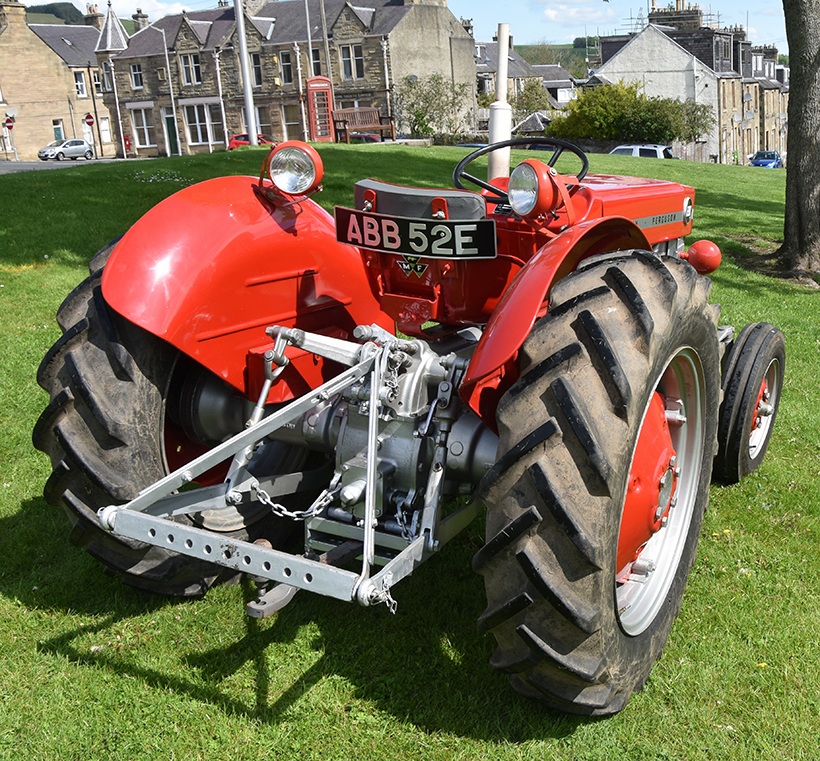
The business end of the 130 reveals more differences between the French and British designs.
In addition to the International, Norman also owns an early petrol/paraffin Fordson E27N, a grey Fergie paired with a contemporary plough, a Massey Ferguson 135 and an E27N crawler.
“The crawler is interesting because it was originally new to the farm I was brought up on, all those years ago,” he explained. “I can still remember the Major turning up one day, and it certainly looked an impressive machine.”
Recent acquisition
“The tractor stayed with the holding for several years, until it was sold on as part of a farm sale. It then did the rounds and, in one of those strange coincidences, finally ended up with a good friend of mine, George Riddell. It took me many years to persuade George to sell the crawler and, due to a lack of space, the tractor is still stored in his shed.”
Norman also acquired his most recent tractor, the Massey Ferguson 130, as part of a disposal sale. “It had belonged to the late Bill Shiel, and I bought it in 2018,” he recalls. “I don’t know a lot about the Massey’s history, except that it was new in 1967, and is wearing a Newcastle-upon-Tyne registration.”
Massey Ferguson faced a lot of competition in the early 1960s, from the likes of David Brown, Ford, International Harvester and Nuffield. The earlier 35 and 65 models had been a success, and the Massey Ferguson Corporate Co-ordinating Committee was set up in 1962 to consolidate the company’s position in the tractor market.
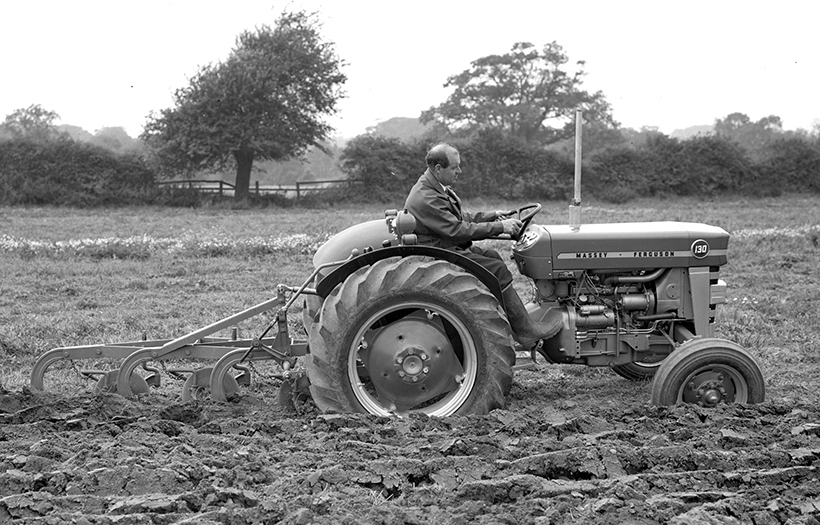
A De Luxe version of the 130 in action with an MF793 plough. (Pic: AGCO)
The aim was to develop a new line of tractors, and emphasis was put on designing similar types of tractor for different markets, to take advantage of economies of scale. The first four tractors in what was the new 100 Series – the ‘DX’ line – were introduced at the 1964 Smithfield Show, in London. Of the MF130, 135, 165 and 175, the larger three tractors were built at Banner Lane in Coventry, featuring Perkins engines and a six-forward, two-reverse transmission as standard.
The MF130 was the baby of the 100 Series, and was built in France. The tractor was aimed at the wine and fruit-growing industries, and was powered by a 1,753cc Perkins A4.107 four-cylinder diesel engine, delivering 30hp at 2,250rpm and 75ft/lb ft of torque at 1,200rpm.
A Vineyard variant was also produced, but it was a choice between Economy and De Luxe versions of the basic model that most buyers had to make a decision on. Visually, integral headlamps showed if an MF130 was a De Luxe version, but other differences were less obvious.
Mechanically, the predominant difference concerned the clutch. An 11-inch, single-plate clutch was fitted to the Economy model, while a dual-plate (11-inch transmission, nine-inch PTO) clutch was fitted to De Luxe tractors.

As an ‘Economy’ variant, Norman’s MF130 simply has an oil pressure gauge and ammeter.
The dual clutch obviously meant that De Luxe MF130s had a live PTO, but they also had ground-speed power take-off too, with one rotation of the shaft achieved with 19 inches of travel. Economy versions of the 130 solely had a power take-off proportional to engine speed, with 24hp available at the shaft for both versions.
Other differences between Economy and De Luxe were road lights and a tractormeter – which were standard on De Luxe only, 4.00-19 front tyres for Economy and 5.50-16 for De Luxe, and a difference in top link – screw-type adjustable for De Luxe and two-piece adjustable for Economy.
Reasonable investment
Compared to other small tractors – Massey Ferguson’s 135 included – the 130 was a little different in that it had dry disc brakes and synchromesh on the top two gears in each range. These were nice features to have on any tractor – let alone a 30hp model.
Lift capacity of the category I linkage was 1,825lb (828kg), with two-way draft control, response control and position control all part of the package. A gear-type pump delivered two gallons per minute at full revs, with oil lines available for delivery and return. An automatic hitch was an optional extra.
The tractor weighed at 2,600lb (1,179kg), but front and rear wheel weights were optional accessories, as was a weight frame and up to eight 60lb (27kg) weights. In December 1967, the list price of an Economy MF130 was £675, while a De Luxe version would have set you back £710.
Norman’s MF130 is an Economy model, but it’s had a few additions to make it more suitable for occasional use. “As I recall, Bill had acquired the Massey Ferguson from an enthusiast in Berwick-upon-Tweed,” Norman said. “He was the one who fitted a different front to the tractor.

Compact in its dimensions and with distinctive, 100 Series styling, the 130 was certainly pleasing to the eye. (Pic: AGCO)
“I’ve carried out my fair share of restorations over the years, but this time around I was looking for a tractor in good condition to take on club road runs,” he said. “I also think some old tractors are a reasonable investment at the moment, bearing in mind the very low interest rates. If you can turn a profit looking after an old tractor, that’s a bonus.”
Norman spent a few weeks tidying the MF130 and touching-up the paintwork. “I also relined the brakes, and added the pair of headlamps,” he explained. “ABB 52E was a basic model and wouldn’t have come supplied with front lights. These were integrated into the front of the tractor on the De Luxe model, but I didn’t want to risk spoiling the metalwork. The Perkins badge is just a bit of fun.”
Norman says the tractor is fun to drive, and the steering is light and straightforward. Although parts of the Scottish borders can be quite hilly, he also says the Massey can keep up with the traffic when it’s taking part in road runs. “These have all been cancelled of late, because of the Covid pandemic, although they’ll hopefully be starting up again in the near future,” he said. “It would be nice to see some of my BVAA friends again, because that’s what collecting tractors is all about.”
| Specification: MF130 | |
| Engine | Perkins A4.107 |
| Cylinders | 4 |
| Power | 30hp |
| Torque | 75lb/ft @1,200rpm |
| Bore | 3 1/8in |
| Stroke | 3½in |
| Displacement | 107cu in |
| Rated speed | 2,250rpm |
| Clutch | Economy: 11in
De Luxe: 11in/9in |
| Transmission | 8 fwd, 2 rev |
| Lift capacity | 1,825lb |
| Length | 109in |
| Wheelbase | 72in |
| Width | 63in* |
| Height | 55in** |
| Ground clearance | 17in |
| Turning circle | 10ft 7in*** |
| Weight | 2,600lb |
| Front tyres | Economy: 4.00-19
De Luxe: 5.50-16 |
| Rear tyres | 10-28 |
* Minimum track
** To top of steering wheel
*** Without brakes
Useful contacts
Agriline Products Ltd.
Stoke Prior, Worcestershire
Tel: 01527 579111
agrilineproducts.com
Chandlers (Farm Equipment) Ltd.
Belton, Lincolnshire
Tel: 01476 590077
chandlersfe.co.uk
John McElderry (Motors & Tractors) Ltd.
Ballymoney, Co. Antrim
Tel: 028 9344 4511
farmingparts.com
Silver Fox Tractor Spares Ltd.
Cornard Tye, Suffolk
Tel: 07753 267067
silverfoxtractorspares.com
For a money-saving subscription to Tractor & Machinery magazine, simply click here



